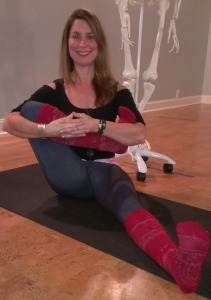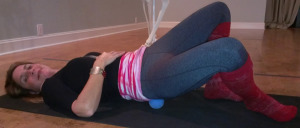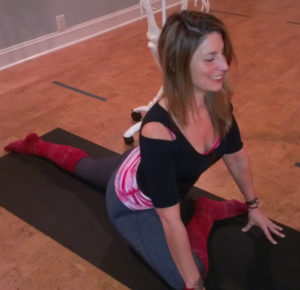Self-care for relieving sciatica
by Nancy B. Loughlin
Published in News Press on December 16, 2014. Posted with permission.
Sciatica hurts.
A warning sign would be a sharp pain that starts in your buttock and shoots down your leg, and it reverberates throughout your body. It’s hard to sit. It’s hard to stand. This compression of the sciatic nerve makes it hard to think about anything else.
You have a pain in your butt, and you need relief. You can go to the doctor, and you can also heal yourself.
Victoria Haffer is a Boston exercise physiologist, wellness coach, and trainer of yoga teachers and personal trainers. While many of her clients have sought medical attention for sciatic pain and piriformis syndrome, she encourages them to learn about their own bodies and explore self-care.
“It’s disempowering to think that you can’t heal yourself,” she said.
Haffer recently conducted a weekend workshop at Ruby and Pearl’s Yoga Studio in Fort Myers where she addressed the healing powers of proprioceptive neuromuscular facilitation (PNF), myofascial release and yin yoga, particularly when it comes to sciatica and piriformis pain.
Three relief techniques
Cradle
PNF is a stretching technique that can increase range of motion and strength. In a PNF stretch, you hold the target muscle in an isometric contraction. When you release the hold, you’ll be able to move deeper into the stretch than before.
- Sit on the floor with a straight back and legs extended. If your back is rounding, prop your seat with a bolster or folded blanket.
- Bend your right leg, and hold it like a baby. Cradle your knee in the elbow of your right arm. The foot is pushing against your left bicep. If you can’t interlace your fingers in front of your bent leg, press your foot into the palm of your left hand.
- Begin the PNF process. Push your right foot away from you toward the front wall, but use the strength of your left arm or hand to hold it in place. Hold the pressure for 8 seconds. Relax for one inhale, and, as you exhale, pull the foot closer to your body, and feel the piriformis stretch. Repeat 3-5 times. Switch sides.
- Cradle your right leg again. This time, instead of pushing your foot away from you, push it against the left bicep or left hand. Use your strength to hold the foot in place while you push. Hold for 8 seconds. Relax for one inhale, and, as you exhale, push your right leg across your body toward the left wall. Repeat 3-5 times. Switch sides.
Roll the ball
Ball rolling is a myofascial release technique of applying extended, blunt pressure to the complaining body part. Haffer describes fascia as a “spider web” of connective tissue that weaves throughout the body. Normally fascia is relaxed, but any kind of trauma, scar or emotional tension can kink the fascia and impact the entire body.
- Use a myofascial release massage ball. A firm tennis ball will do.
- Lie on your back with your legs bent, soles to the floor.
- Place the ball in the middle of the right buttock. Hold still or shift your weight from your outer hip to your sacrum. Breathe.
Pigeon
In a yin yoga practice, poses are held for 3 to 5 minutes. With the longer holds, you’ll access the connective tissue not just the muscle.
- Start with your right side. Pigeon looks like a half split. Your left leg is straight behind you, knee facing down. Your right leg is bent with the outside of the leg flat on the floor. Your right knee is closer to the right edge of the mat with your right toe pointing toward the left edge. Ideally, your right shin is parallel to the front edge of the mat. If you are collapsing onto your right side, push a blanket or block underneath your right buttock.
- Keep your heart lifted with your palms on the floor. If you are flexible enough, drop to your forearms or rest your head on the floor. Hold and breathe. Switch sides.
Relief is on the way.
For more information, visit www.VictoriaHaffer.com.



